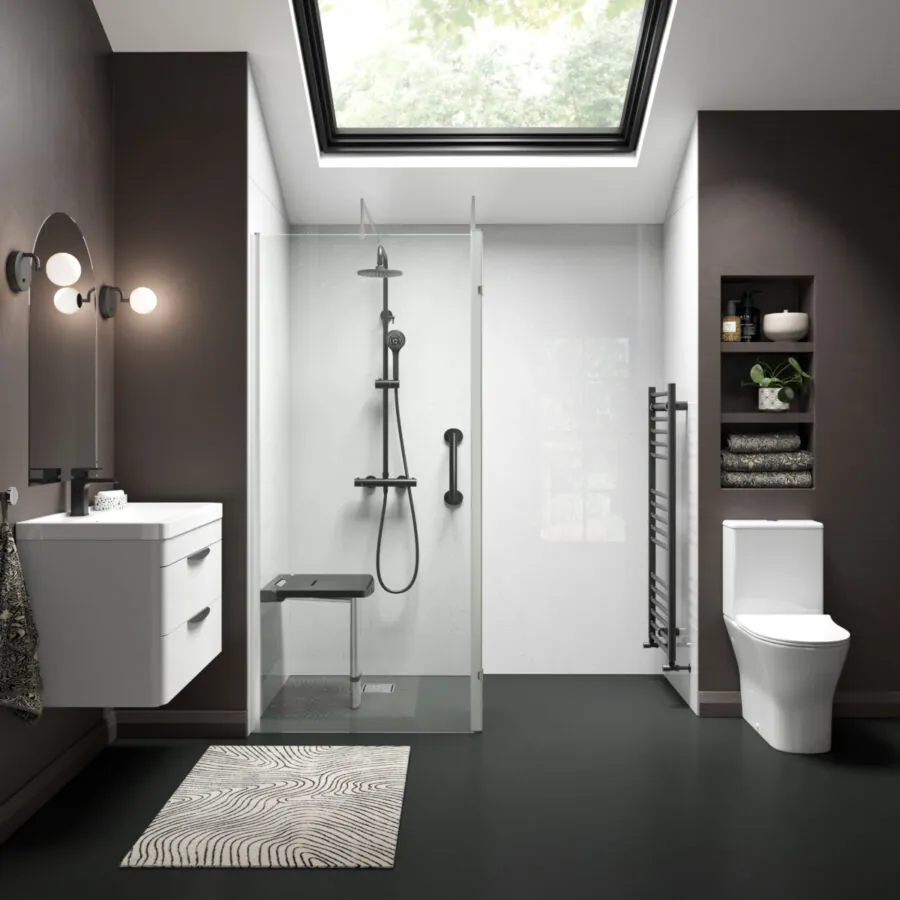
Creating a bathroom that seamlessly combines safety, comfort and accessibility is a priority for many homeowners, particularly the elderly, wheelchair users or those with mobility challenges.
The decision between a walk-in bath vs. a walk-in shower is important, relying on personal preferences and practical considerations. On this page, we’ll explore the benefits and considerations of both options, helping you decide which one will suit your needs best.
Get a FREE Brochure
Simply complete our form to see a full range of bathing solutions & their key features. It takes no time at all!
- Walk-in bath vs. shower: bathroom accessibility
- Walk-in bath vs. shower for small bathrooms
- Walk-in bath vs. shower for large bathrooms
- Walk-in bath vs. shower for mobility adaptions
Walk-in bath vs. shower: bathroom accessibility
When it comes to assistive bathing and bathroom accessibility, the choice between a walk-in bath and a walk-in shower depends on the person’s specific needs, preferences and level of mobility.
Choose a walk-in bath if: you have balance problems or poor core strength, have other people in the house who need a bath (e.g. family members), or you want to relax your muscles when suffering from joint pain.
Choose a walk-in shower if: you value speed and ease of use, or if you’re a wheelchair user who requires unrestricted access.
For more information, here’s a breakdown of the advantages and considerations for both bathing options:
Walk-in bath advantages
- Low step height – Similar to walk-in showers, walk-in baths have low thresholds to make entry and exit easier compared to a traditional bath.
- Comfortable bathing – For people who want to spend a bit longer bathing than the average shower, a walk-in bath allows you to continue enjoying the relaxation and comfort of a bath.
- Assistance features – Some models come with power seats to aid in sitting down and standing up within the bath, providing additional support.
- More therapeutic – Unlike showers, some walk-in baths come with therapeutic features like spa therapy and chromotherapy to help create an even more relaxing bathing experience, which can be especially helpful for those with joint conditions, such as arthritis.
- Multi-functional – walk-in baths are useful if you have other members of the house who also need a bath to bathe.
Walk-in bath considerations
- Takes time to fill up and drain – unlike a shower, walk-in baths require entering an empty tub and waiting for the water to fill before bathing. You also need to wait for the bath to drain before opening the door and exiting.
However, employing a thermostatically controlled water system guarantees a consistently comfortable water temperature as you wait. Another answer to the period between filling and draining the bath is the heated seat option, available on some models, that keeps you warm while the bath fills or drains.
- Higher threshold – although walk-in baths have low-entry compared to a standard bath, the threshold will be higher than a walk-in shower or wet room. This should be considered when getting in or out.
- More floor space – walk-in baths might take up more space in the bathroom compared to a shower. However, if you have a small bathroom, you can install compact walk-in bathrooms to save even more space.
Walk-in shower advantages
- Easier access – walk-in showers generally provide easier entry than walk-in baths, with low or no step heights, making them suitable for people with reduced mobility or wheelchair users.
- Quick and efficient – showers are quicker than baths, which might be preferred for people with limited time or energy.
- Versatile design – walk-in showers can be customised to meet specific accessibility needs, including the addition of grab bars, seats, and other assistive features.
- Reduced risk – like walk-in baths, the absence of a high step reduces the risk of tripping and falling, making it safer for people with mobility issues.
Walk-in shower considerations
- Personal preference – some people simply prefer baths and might not find showers as enjoyable or relaxing.
- Differing routines – transitioning from baths to showers might require adapting to a new bathing routine.
Overall, the bath vs. shower debate for bathroom accessibility depends on personal preference, mobility level, and individual needs. Walk-in showers generally offer better accessibility for wheelchair users and the elderly, allowing users to simply enter and exit without using steps or doors.
However, for people who highly value the therapeutic and comfortable experience of a bath, a walk-in bath with assistive features is the better option. And with slip-resistant surfaces and power seating walk-in baths become much easier to use for elderly people or those with limited mobility.
As always, it’s important to assess the individual’s requirements and preferences before making a decision.
Walk-in bath vs. shower for small bathrooms
Walk-in showers are generally more suitable for small bathrooms than walk-in baths because they take up less floor space. For instance, a standard bathtub typically measures 1700 mm in length and 700 mm in width, while a walk-in shower enclosure generally measures 1200 mm by 900 mm.
Still, walk-in showers aren’t suitable for everyone’s taste or bathing routine. If you want to save space with a walk-in bath in your small bathroom, then you can install a compact walk-in bath – such as The Majestic or The Harmony – instead. They take up far less space than regular walk-in baths while offering a relaxing bathing experience for people with limited mobility.
If you don’t mind using a shower or bath, then start by measuring your bathroom and imagining whether a walk-in shower or a bathtub would integrate more seamlessly. Will there be ample room for a tub to comfortably fit, or is a walk-in shower a more practical choice given the limited space you have?
Walk-in bath vs. shower for large bathrooms
If you’re wondering whether showers are better than baths for large bathrooms, it comes down to personal preferences – unlike small bathrooms, larger rooms have enough space for either. Or even both.
For large bathrooms, a walk-in shower can help you optimise the available area and create an open ambiance. You can also personalise the shower with extra safety or design elements, such as grab rails or built-in seating. Meanwhile, walk-in showers come in stylish designs and can contribute to a modern aesthetic, ideal for big and bright bathrooms.
Alternatively, a walk-in bath in a larger bathroom can provide a relaxing and comforting soaking experience, ideal for those who prioritise leisurely baths or have difficulty standing.
However, the ultimate answer to the bath vs. shower debate is to combine them both. Rather than deciding between the two, you can install a shower-over-bath – such as The Royale – allowing you to choose when you’d like to stand and have a shower or lie down and soak in the tub.
The decision ultimately hinges on the bather’s preferences, lifestyle, and desired bathroom functionality.
Walk-in bath vs. shower for mobility adaptions
The right choice comes down to the user’s level of mobility. Walk-in showers are the better option for wheelchair users, while walk-in baths offer a variety of safety and comfort features that can help elderly people regain independence.
For wheelchair users, walk-in showers allow easier access than baths thanks to their ultra-low thresholds. In truth, wet rooms are the best solution for wheelchair users, offering unrivalled ease of access.
You can also install additional safety features to walk-in showers and wet rooms, such as grab bars and slip-resistant surfaces, which are ideal for users of all mobility levels, particularly wheelchair users and elderly people.
With walk-in baths, there are several features you can install to help the bather enjoy a safe and relaxing bath, including grab rails, slip-resistant floor, and power seating to help lower the bather into the tub. No matter which one you pick in the bath vs. shower discussion, you’ll find there are plenty of ways to increase safety, mobility and independence in the bathroom.






